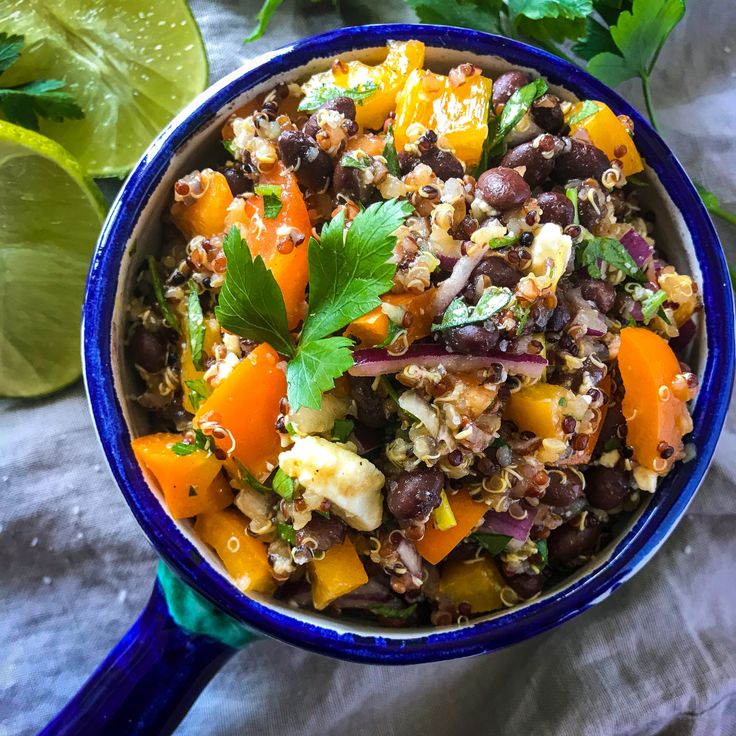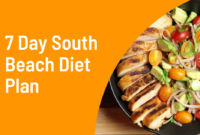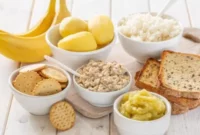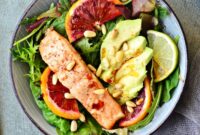Quinoa South Beach Diet: This exploration delves into the compatibility of quinoa, a nutritional powerhouse, with the principles of the popular South Beach Diet. We’ll examine quinoa’s macronutrient profile, its glycemic impact, and how it integrates into the diet’s various phases. Discover delicious recipes and learn how to maximize quinoa’s benefits while achieving your weight management goals.
Understanding the interplay between quinoa and the South Beach Diet requires a nuanced approach. This guide provides a detailed analysis of quinoa’s nutritional value, comparing it to other grains frequently used in the diet. We’ll address potential challenges, offer practical solutions, and present a comprehensive overview to help you confidently incorporate quinoa into your South Beach journey.
Quinoa Nutritional Profile in the Context of the South Beach Diet
Quinoa, an ancient grain, has gained popularity as a healthy and versatile food. Its nutritional profile aligns well with the principles of the South Beach Diet, which emphasizes whole grains, lean protein, and healthy fats while limiting refined carbohydrates and added sugars. Understanding quinoa’s macronutrient composition and its impact on blood sugar is crucial for determining its suitability within this dietary framework.
Macronutrient Composition of Quinoa
Quinoa offers a balanced macronutrient profile. A one-cup serving of cooked quinoa contains approximately 222 calories, 8 grams of protein, 39 grams of carbohydrates, and 4 grams of fat. The carbohydrate content is relatively high compared to some other South Beach-friendly options, but a significant portion of these carbohydrates are complex and provide sustained energy release. The protein content is notably higher than in many other grains, making quinoa a valuable source of this essential macronutrient. The fat content is moderate and primarily consists of unsaturated fatty acids, beneficial for heart health.
Glycemic Index of Quinoa Compared to Other Grains
The glycemic index (GI) measures how quickly a carbohydrate-containing food raises blood glucose levels. Quinoa boasts a relatively low GI, typically ranging from 53 to 70, depending on factors like preparation method. This is lower than many refined grains like white bread (high GI) but comparable to some other whole grains often included in South Beach Diet plans, such as brown rice (GI around 50-60). The lower GI of quinoa contributes to its suitability for individuals aiming for stable blood sugar levels.
Fiber Content of Quinoa and Its Impact on Satiety and Blood Sugar Regulation
Quinoa is an excellent source of dietary fiber, with approximately 5 grams per cooked cup. Fiber plays a vital role in promoting satiety, meaning it helps you feel fuller for longer, which can be beneficial for weight management. Furthermore, fiber slows down the digestion and absorption of carbohydrates, leading to a more gradual increase in blood sugar levels and preventing sharp spikes. This is particularly advantageous for individuals following the South Beach Diet, which emphasizes blood sugar control.
Vitamin and Mineral Content of Quinoa
Quinoa is a nutritional powerhouse, rich in various vitamins and minerals. It’s a good source of magnesium, crucial for muscle function and blood sugar regulation; manganese, involved in bone health and metabolism; and phosphorus, essential for energy production and cell growth. It also contains iron, zinc, and several B vitamins, all of which contribute to overall health and well-being, aligning with the holistic approach of the South Beach Diet. The presence of these micronutrients further enhances quinoa’s nutritional value within the context of this dietary plan.
Quinoa Recipes Suitable for the South Beach Diet
Quinoa’s versatility and nutritional profile make it an excellent addition to the South Beach Diet, offering a satisfying and healthy alternative to traditional grains. The following recipes demonstrate how quinoa can be incorporated into delicious and phase-appropriate meals. Each recipe prioritizes healthy fats, lean protein, and non-starchy vegetables, aligning perfectly with the diet’s principles.
Mediterranean Quinoa Salad
This vibrant salad is packed with flavor and nutrients, making it a perfect light lunch or side dish. It’s easily adaptable to your preferred vegetables and herbs.
- Ingredients: 1 cup cooked quinoa, ½ cup chopped cucumber, ½ cup chopped tomatoes, ¼ cup crumbled feta cheese, ¼ cup Kalamata olives (halved), 2 tablespoons olive oil, 1 tablespoon lemon juice, 1 teaspoon dried oregano, salt and pepper to taste.
- Preparation: Combine cooked quinoa, cucumber, tomatoes, feta cheese, and olives in a bowl. Whisk together olive oil, lemon juice, oregano, salt, and pepper. Pour dressing over the quinoa mixture and toss gently to combine.
Nutritional Information (per serving): Approximate values will vary based on specific ingredients used. This is an estimate based on common ingredient values. Calories: Approximately 350; Protein: 12g; Fat: 18g (mostly healthy unsaturated fats); Carbohydrates: 35g; Fiber: 5g. Vitamins and minerals include Vitamin C from tomatoes, Vitamin K from olives, calcium and protein from feta cheese. The exact amounts will depend on the specific ingredients used.
Texture and Flavor Profile: This salad offers a delightful combination of textures – the fluffy quinoa, crisp cucumber, and juicy tomatoes. The flavors are bright and Mediterranean-inspired, with a zesty lemon dressing and salty feta cheese complementing the earthy quinoa. The high fiber content contributes to satiety, making it suitable for the South Beach Diet.
Quinoa and Shrimp Stir-Fry
This quick and easy stir-fry is a perfect weeknight meal, offering a lean protein source with plenty of vegetables.
- Ingredients: 1 cup cooked quinoa, ½ cup cooked shrimp (peeled and deveined), 1 cup broccoli florets, ½ cup sliced bell peppers (any color), 2 tablespoons soy sauce (low sodium), 1 tablespoon sesame oil, 1 clove garlic (minced), ½ teaspoon ginger (grated), salt and pepper to taste.
- Preparation: Heat sesame oil in a wok or large skillet over medium-high heat. Add garlic and ginger and stir-fry for 30 seconds. Add broccoli and bell peppers and stir-fry for 3-4 minutes until slightly tender-crisp. Add shrimp and stir-fry for 2-3 minutes until pink and cooked through. Stir in cooked quinoa and soy sauce. Season with salt and pepper to taste.
Nutritional Information (per serving): Approximate values will vary based on specific ingredients used. Calories: Approximately 300; Protein: 25g; Fat: 10g; Carbohydrates: 30g; Fiber: 4g. Vitamins and minerals include Vitamin C from bell peppers, protein from shrimp, and various minerals from quinoa. The exact amounts will depend on the specific ingredients used.
Texture and Flavor Profile: This stir-fry offers a satisfying combination of textures – the fluffy quinoa, tender shrimp, and slightly crunchy vegetables. The flavors are savory and slightly sweet, with a hint of ginger and garlic. The lean protein from shrimp and abundance of vegetables make it a perfect South Beach Diet-friendly meal.
Spicy Quinoa and Black Bean Bowl
This hearty bowl is packed with flavor and protein, perfect for a satisfying and healthy meal.
- Ingredients: 1 cup cooked quinoa, ½ cup black beans (rinsed and drained), ½ cup chopped red onion, ½ cup chopped avocado, ¼ cup chopped cilantro, 2 tablespoons salsa, 1 tablespoon lime juice, ½ teaspoon chili powder, salt and pepper to taste.
- Preparation: Combine cooked quinoa, black beans, red onion, avocado, and cilantro in a bowl. Whisk together salsa, lime juice, chili powder, salt, and pepper. Pour dressing over the quinoa mixture and toss gently to combine.
Nutritional Information (per serving): Approximate values will vary based on specific ingredients used. Calories: Approximately 400; Protein: 15g; Fat: 15g (mostly healthy unsaturated fats); Carbohydrates: 50g; Fiber: 10g. Vitamins and minerals include fiber from black beans and quinoa, healthy fats from avocado, and Vitamin C from salsa. The exact amounts will depend on the specific ingredients used.
Texture and Flavor Profile: This bowl offers a delightful combination of textures – the fluffy quinoa, creamy avocado, and slightly crunchy red onion. The flavors are bold and spicy, with a zesty lime dressing and a hint of chili powder complementing the earthy quinoa and hearty black beans. The high fiber content and healthy fats contribute to satiety, making it suitable for the South Beach Diet.
Comparing Quinoa to Other South Beach Diet-Friendly Grains
The South Beach Diet emphasizes low-glycemic carbohydrates, lean protein, and healthy fats. Several grains fit this profile, each offering unique nutritional benefits and impacting blood sugar differently. Understanding these differences is crucial for optimizing weight management and overall health within the context of the diet. This comparison focuses on quinoa, brown rice, and oats, highlighting their relative strengths and weaknesses.
Nutritional Comparison of Grains
The following table provides a comparative overview of the nutritional profiles of quinoa, brown rice, and oats, focusing on aspects relevant to the South Beach Diet:
| Grain | Glycemic Index (GI) | Fiber Content (per cup cooked) | Protein Content (per cup cooked) |
|---|---|---|---|
| Quinoa | 53 | 5g | 8g |
| Brown Rice | 55-68 (varies by type and preparation) | 3.5g | 5g |
| Oats (rolled) | 55-70 (varies by type and processing) | 4g | 5g |
*Note: Glycemic Index values can vary depending on factors like processing and cooking methods. Fiber and protein content can also fluctuate based on serving size and specific variety.*
Impact on Blood Sugar and Insulin Response
Quinoa, with its lower to moderate glycemic index, generally causes a slower and more gradual rise in blood sugar compared to brown rice or oats, particularly processed oats which can have a higher GI. This translates to a more controlled insulin response, reducing the risk of blood sugar spikes and crashes. Brown rice and oats, while still relatively low GI compared to white rice or refined grains, can still elicit a more significant insulin response than quinoa, particularly if consumed in large quantities or without sufficient fat and protein. The fiber content in all three grains contributes to slower digestion and improved blood sugar control.
Advantages and Disadvantages in Weight Management and Overall Health
Quinoa’s high protein content makes it particularly advantageous for satiety and weight management. Its complete protein profile, meaning it contains all nine essential amino acids, further enhances its value. Brown rice offers a good source of fiber and several B vitamins, supporting digestive health and energy levels. Oats, particularly rolled oats, are rich in soluble fiber, which contributes to cholesterol management and improved gut health. However, the glycemic index of brown rice and oats can be higher than quinoa, potentially leading to greater blood sugar fluctuations for some individuals, especially those with insulin resistance.
Grain Selection Based on Individual Needs
The optimal grain choice depends on individual dietary needs and goals. Individuals highly sensitive to blood sugar fluctuations might benefit from prioritizing quinoa due to its lower glycemic index. Those focused on maximizing protein intake for muscle building or satiety might also favor quinoa. Individuals seeking a readily available and versatile grain with good fiber content might opt for brown rice or oats. The choice often involves balancing the nutritional benefits with individual metabolic responses and preferences. For instance, someone aiming for maximum fiber intake might prefer oats, while someone with a history of blood sugar issues might prioritize quinoa.
Epilogue
Successfully integrating quinoa into the South Beach Diet offers a path to achieving your health and weight goals. By understanding its nutritional properties and how it fits within the different phases, you can enjoy its versatility and benefits while adhering to the diet’s principles. Remember to prioritize balanced meals, mindful portion control, and consult with a healthcare professional for personalized guidance.




